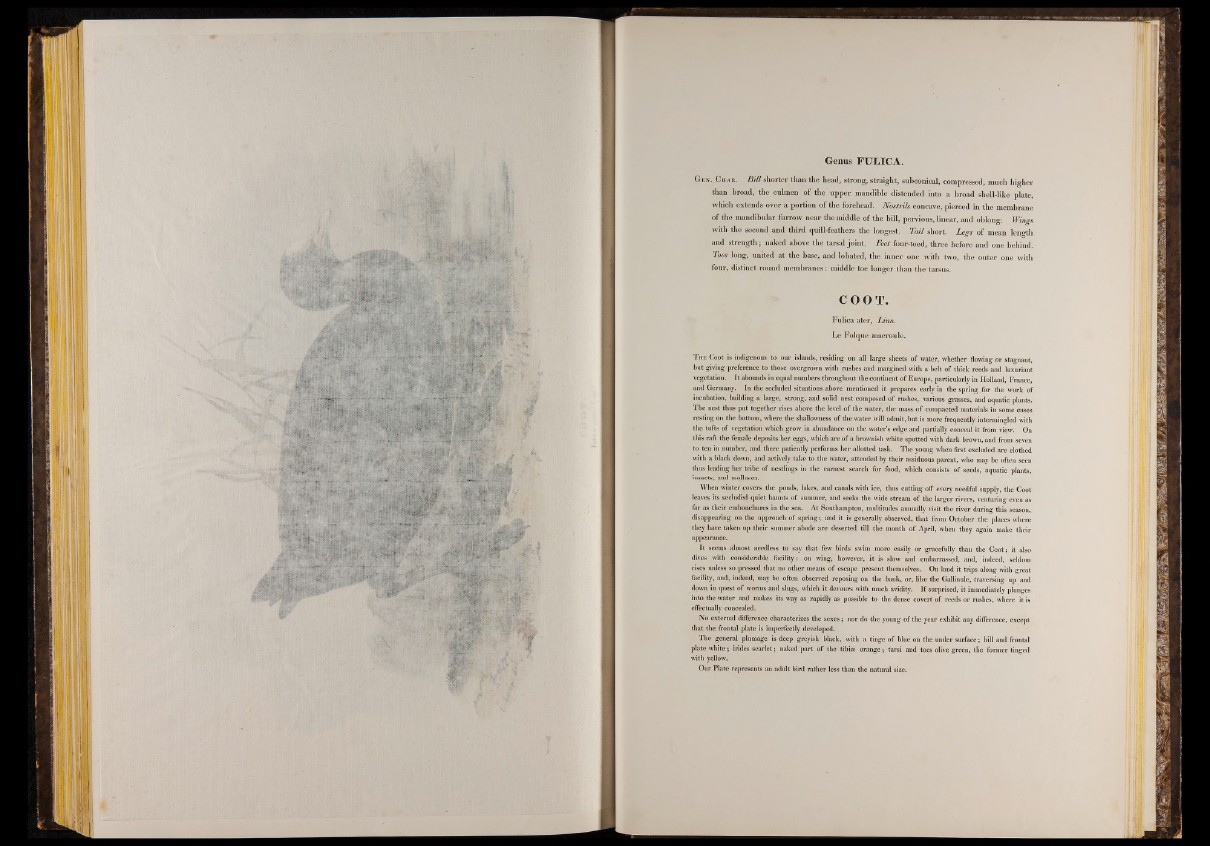
Genus FULICA.
G e n . . C h a r . -B?//shorter than the head, strong, straigh t, subconical, compressed, mu ch h igh e r
than broad , the culmen o f th e u p p e r man dib le distended into a b road she ll-lik e plate,
w h ich ex ten ds o v e r a portion o f th e forehead. N o s tr ils concave, pie rced in th e membrane
o f th e man dibula r fu r row n ea r th e m iddle o f th e b ill, pervious, linear, and o blon g. W ings
w ith th e second and th ird quill-feathers th e longest. T a il short. L e g s o f mean len g th
and s t r en g th ; n ak ed ab ove th e tarsal jo in t . F e e t four-toed, th ree before and one behind.
Toes lon g , un ited a t th e base, and iob a ted , th e in n e r one w ith tw o , th e o u te r one w ith
fou r, distinct round m em b ran e s : middle toe lo n g e r than th e tarsus.
COOT.
F u lic a ater, L in n .
L e F o lq u e macroule.
T he Coot is indigenous to our islands, residing on all large sheets o f water, whether flowing or stagnant,
but giving preference to those overgrown with rushes and margined with a belt o f thick reeds and luxuriant
vegetation. It abounds in equal numbers throughout the continent o f Europe, particularly in Holland, France,
and Germany. In the secluded situations above mentioned it prepares early in the spring for the work of
incubation, building a large, strong, and solid nest composed o f rushes, various grasses, and aquatic plants.
The nest thus put together rises above the level o f the water, the mass o f compacted materials in some cases
resting on the bottom, where the shallowness o f the water will admit, but is more frequently intermingled with
the tufts o f vegetation which grow in abundance on the water’s edge and partially conceal it from view. On
this raft the female deposits her eggs, which are o f a brownish white spotted with dark brown, and from seven
to ten in number, and there patiently performs her allotted task. The young when first excluded are clothed
with a black down, and actively take to the water, attended by their assiduous parent, who may be often seen
thus leading her tribe o f nestlings in the earnest search for food, which consists o f seeds, aquatic plants,
insects, and mollusca.
When winter covers the ponds, lakes, and canals with ice, thus cutting o ff every needful supply, the Coot
leaves its secluded quiet haunts o f summer, and seeks the wide stream o f the larger rivers, venturing even as
far as their embouchures in the sea. A t Southampton, multitudes annually visit the river during this season,
disappearing on the approach o f spring; and it is generally observed, that from October the places where
they have taken up their summer abode are deserted till the month o f April, when they again make their
appearance.
It seems almost needless to say that few birds swim more easily or gracefully than the Coot; it also
dives with considerable facility: on wing, however, it is slow and embarrassed, and, indeed, seldom
rises unless so pressed that no other means o f escape present themselves. On land it trips along with great
facility, and, indeed, may be often observed reposing on the bank, or, like the Gallinule, traversing up and
down in quest o f worms and slugs, which it devours with much avidity. I f surprised, it immediately plunges
into the water and makes its way as rapidly as possible to the dense covert o f reeds or rushes, where it is
effectually concealed.
No external difference characterizes the sexes; nor do the young o f the year exhibit any difference, except
that the frontal plate is imperfectly developed.
The general plumage is deep greyish black, with a tinge o f blue on the under surface; bill and frontal
plate white; irides scarlet; naked part o f the tibiae orange; tarsi and toes olive green, the former tinged
with yellow.
Our Plate represents an adult bird rather less than the natural size.